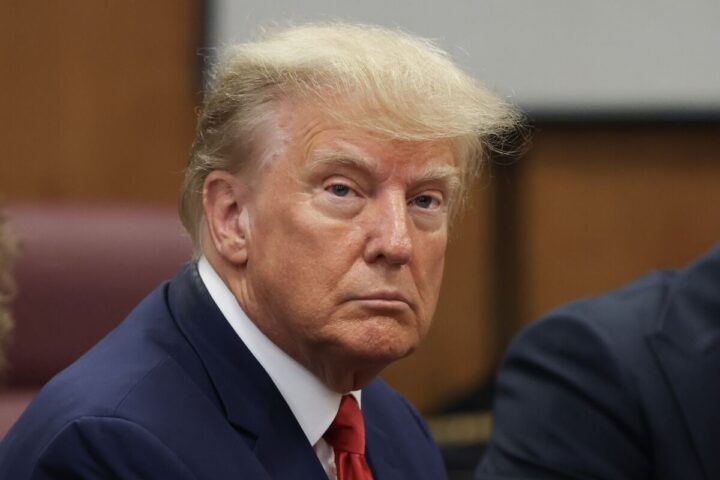Bitcoin approached the $42,000 mark as the week closed on January 21, but it was far from a stellar week for the cryptocurrency bulls.
Data from Cointelegraph Markets Pro and TradingView indicated that Bitcoin’s price managed to stabilize above the $41,000 level during the weekend, although it had dipped to $40,270 on Bitstamp earlier in the week, marking its lowest point since December 11.
The cryptocurrency landscape seemed less optimistic for those hoping for new all-time highs, as market participants anxiously awaited the weekly close and the resumption of Wall Street trading.
Popular trader and analyst Rekt Capital warned that Bitcoin had dropped below the Weekly Range Low after encountering new resistance, and a weekly close below this level could initiate a bearish trend.
Crypto Tony, another trader, expressed the possibility of Bitcoin dropping below $40,000, possibly before the block subsidy halving scheduled for April.
Additionally, Joe McCann, founder of the crypto fund Asymmetric, highlighted the dwindling trading volume in Bitcoin since the launch of exchange-traded funds (ETFs), which had been anticipated.
The spotlight remained on the United States’ spot Bitcoin ETFs, which had grown their assets under management to nearly $4 billion since their introduction on January 11.
READ MORE: Sam Altman’s Ambitious Plans to Establish Global Semiconductor Manufacturing Facilities
These ETFs helped mitigate the impact of selling from the Grayscale Bitcoin Trust (GBTC), which had recently transitioned into an ETF. GBTC had experienced outflows due to high maintenance fees and investors seeking to cash out at par value, as previously GBTC shares had traded at a substantial discount compared to BTC/USD.
Trading firm QCP Capital noted that GBTC had witnessed outflows of $1.17 billion since its conversion into an ETF and emphasized the significance of monitoring these outflows moving forward.
The conversion into an ETF offered GBTC holders a long-awaited opportunity to exit at par value, but the extent of remaining outflows from GBTC’s current $25.4 billion assets under management remained uncertain.
Looking ahead, QCP Capital pointed out that the next major crypto events to watch were the Bitcoin halving in mid-April and the potential approval of Ethereum (ETH) spot ETFs starting in May.
Additionally, macroeconomic events were expected to influence the direction of the cryptocurrency market in the interim.
In the inaugural week of trading for United States spot Bitcoin exchange-traded funds (ETFs), an astonishing influx of capital surged into these new investment vehicles.
However, amidst their remarkable popularity, voices from the crypto world are raising concerns, contending that these ETFs might contradict the core principles upon which cryptocurrencies were founded.
On January 10, the U.S. Securities and Exchange Commission granted approval to multiple spot Bitcoin ETFs, marking a historic milestone.
Subsequently, on January 11, these ETFs commenced trading, and the demand for them became glaringly evident, with trading volumes surging to $10 billion within the first week.
Furthermore, the Bitcoin ETF market witnessed an impressive influx of over $782 million in just the initial two days of trading.
Nonetheless, despite their undeniable popularity, some crypto executives are sounding alarms, suggesting that ETFs could result in increased centralization within the crypto industry and may eventually become obsolete.
Andy Bromberg, the CEO of wallet developer Eco, expressed concerns about the potential for traditional financial institutions to gain excessive influence through Bitcoin ETFs.
He argued that when investors buy into these ETFs, they essentially provide Wall Street with funds to purchase Bitcoin, while they themselves only own a share on paper.
He lamented that this deviates from the original ideals of Bitcoin, emphasizing that it may lead to Wall Street institutions controlling a significant portion of the circulating Bitcoin supply.
Bromberg criticized ETFs as a stripped-down version of Bitcoin, removing the technology’s intrinsic features and focusing solely on its price.
However, he did acknowledge the importance of ETF approval, as it allows Americans to express their opinions on Bitcoin within the financial markets.
READ MORE: U.S. Regulators Investigate Debiex Exchange for Alleged Romance-Driven Crypto Swindle
Still, he stressed that the crypto community faces a critical test in guiding new investors toward self-custodying their assets to prevent Wall Street dominance.
Bromberg suggested that developers should create user-friendly products that provide asset custody while maintaining the core promises of crypto.
Lucas Henning, CTO for the Suku wallet development team, shared Bromberg’s reservations about Bitcoin ETFs.
He argued that ETFs may not sustain public interest for long, particularly as the SEC’s approval of other cryptocurrencies for ETFs remains uncertain.
He highlighted that most crypto yields might not be accessible through traditional brokerage accounts.
Henning also pointed out the increasing ease of self-custodying crypto assets, particularly within the Ethereum ecosystem, due to developments like Ethereum Improvement Proposal 7212.
This proposal would allow on-chain signatures using facial recognition technology, simplifying the process for users to sign transactions securely, reducing the need for ETFs to manage their assets.
In conclusion, while Bitcoin ETFs have garnered significant attention and investment, there are concerns within the crypto community that they might compromise the core principles of decentralization.
Some experts believe that as self-custodying options improve, the appeal of ETFs may wane, ultimately shaping the future of crypto investment.
Bitcoin struggled to maintain its position near monthly lows as it approached the Wall Street opening on January 20th, while Ether encountered significant resistance in its upward journey.
Bitcoin faced substantial sell-side pressure, with its price hovering around $40,600 overnight, marking its lowest point since December 18th. Bulls repeatedly failed to regain lost ground, creating a tense atmosphere in the market.
Michaël van de Poppe, the founder and CEO of MN Trading, suggested that a potential price floor for Bitcoin might be in the mid-$30,000 range, although he believed further testing of lower levels might occur before a reversal.
He expressed personal interest in accumulating Bitcoin between $36,000 and $40,000.
Rekt Capital, a popular trader and analyst, supported the idea that Bitcoin was following patterns typically observed before block subsidy halvings.
This pattern could indicate a retreat in the coming month before the halving event scheduled for April.
Additionally, a significant number of Bitcoin sales occurred during the recent dip, with approximately 59,000 BTC moving on-chain for the first time in three to six months.
These coins were originally acquired at an average cost of $26,000, resulting in a realized profit of nearly $900 million.
READ MORE: ProShares Sets Sights on Bitcoin ETFs with Indirect Exposure Amidst Growing Market Demand
Earlier research had attributed the drop from $49,000 the previous week to large-scale whale selling.
In the world of altcoins, attention shifted to ETH/BTC, which had been on a downward trendline for an extended period.
Ether had made notable gains against Bitcoin in the past week, surpassing the 0.06 BTC mark before consolidating at that level, its highest since April 2022.
This consolidation was occurring at a resistance trendline and above the 200-day moving average cloud, according to Caleb Franzen, a senior analyst at Cubic Analytics.
Franzen’s analysis referenced data indicating that ETH/USD was likely to outperform BTC/USD in the future.
In summary, Bitcoin faced significant sell-side pressure and hovered near monthly lows, with experts suggesting potential price floors.
Meanwhile, Ether encountered resistance against Bitcoin and consolidated near a crucial resistance trendline, indicating potential strength in the ETH/USD pair going forward.
Bitcoin traders are facing a challenging time as the recent sell-off in the market has left them disappointed, with newly launched spot Bitcoin exchange-traded funds (ETFs) failing to deliver the anticipated price surge.
Adding to their concerns, the steady outflows from the Grayscale Bitcoin Trust (GBTC) have been putting downward pressure on the Bitcoin price.
To make matters more complex, there is a strong resurgence of the U.S. dollar, compounding the challenges for market participants.
The U.S. Dollar Index (DXY), a gauge of the dollar’s performance against major foreign currencies, has shown a remarkable recovery, surging by 2.71% from its low of 100.617 on December 27th.
This resurgence has been fueled by positive economic data from the United States, including robust retail sales, an upbeat Philly Fed Manufacturing Index, and a decline in weekly initial jobless claims.
Consequently, the DXY has reached new highs in the range of 103.65 to 103.70 in 2024.
December 2023 retail sales, as reported by the U.S. Census Bureau, exceeded expectations with a growth rate of 0.6%, surpassing the anticipated 0.4% and the previous period’s 0.3%.
Moreover, the dollar’s recovery can be attributed to an increase in U.S. yields, driven by diminishing expectations of an imminent interest rate cut by the Federal Reserve.
From a technical perspective, the U.S. Dollar Index appears poised for a further ascent, potentially exceeding 1.12% due to the formation of a V-shaped recovery pattern.
If the DXY manages to breach its neckline at 104.56, the likelihood of an extended recovery towards 107 in the coming months is on the horizon.
Meanwhile, the massive outflows from GBTC have significantly impacted the Bitcoin price since the launch of spot Bitcoin ETFs on January 11th.
Grayscale has liquidated a substantial portion of its Bitcoin holdings within GBTC, with nearly 38,000 BTC leaving since the conversion to a spot ETF on that date.
On January 12th alone, there were outflows totaling $484 million from Grayscale, as GBTC holders exercised open redemption options.
Notably, despite the approval of spot Bitcoin ETFs, economist Peter Schiff believes that the Bitcoin price has not surged due to the outflows from Grayscale’s GBTC product.
He argues that while total inflows were substantial, their impact on the overall BTC market has been limited.
In terms of price analysis, independent market analyst Ali suggests that Bitcoin has been moving within an ascending parallel channel since late 2022.
He attributes the current correction to a rejection from the upper boundary of the channel at $48,000 and predicts a retracement to the lower boundary at $34,000.
Nevertheless, market intelligence firm Santimet remains optimistic about the long-term impact of spot Bitcoin ETFs.
READ MORE: Netherlands Allocates €204.5 Million to Boost AI Investment and Competitiveness
They acknowledge that the approval news may have contributed to a localized crypto market peak, as many experts believed that the approvals were already factored into market prices at the time of the announcements.
On January 19, the United States Securities and Exchange Commission (SEC) made a significant move by acknowledging the proposals submitted by Nasdaq and the Cboe regarding the introduction of options trading for Bitcoin exchange-traded funds (ETFs).
Nasdaq initiated a rule change request to facilitate the listing and trading of options linked to BlackRock’s iShares Bitcoin Trust, while the Cboe applied for permission to trade options linked to “ETPs (exchange-traded products) that Hold Bitcoin.”
Notably, the Cboe had recently launched six out of the ten BTC ETFs that had received SEC approval.
The much-anticipated BTC ETFs commenced trading on both the Nasdaq and Cboe platforms on January 11, just one day after obtaining approval from the SEC.
Catherine Clay, the Executive Vice President of Cboe, disclosed that the exchange was experiencing “good inflows” into the BTC ETFs, which were closely tracking the price of Bitcoin, aligning with expectations.
According to Clay, introducing BTC ETF options trading was the “next logical step” for these products, as it would enhance their utility and provide risk mitigation capabilities.
Nasdaq supported this notion by stating that options would deliver “cost efficiencies and increased hedging strategies.”
Options are financial derivatives that grant the holder the right to buy or sell an asset at a predetermined price and time.
READ MORE: TrueUSD Implements Daily Attestations Amid Dollar Peg Struggles
Analyst Dave Nadig from VettaFi suggested that this move could attract various hedge fund players to the BTC ETF options space who may not have previously ventured into the cryptocurrency ecosystem directly.
Cboe submitted its request for options trading permission just last week, and Clay expressed uncertainty regarding the regulatory approval process, emphasizing that it was challenging to predict the outcome.
Moreover, Cboe’s options clearing corporation had to make corresponding filings with both the SEC and the Commodity Futures Trading Commission, adding an additional layer of complexity to the situation.
James Seyffart, an ETF analyst at Bloomberg, noted the unexpected speed at which Nasdaq had made its announcement, suggesting that approval for options trading could potentially be granted as early as the end of February, or at the latest, around September 21.
These proposals are now open for public comment for a period of 21 days after their publication in the Federal Register, allowing stakeholders and interested parties to provide their input and perspectives on this pivotal development in the cryptocurrency and financial markets.
On the fifth day of trading, issuers of Spot Bitcoin exchange-traded funds (ETFs) made a significant addition to their crypto holdings, accumulating a net total of 10,667 Bitcoins.
The trading activity was accompanied by a surge in trading volumes, indicating growing interest in these investment products.
Data provided by the X (formerly known as Twitter) account CC15Capital for January 17 reveals that a substantial $440 million worth of Bitcoin was added to the ETF holdings by the end of the trading day.
Notably, BlackRock’s ETF led the pack, acquiring 8,700 BTC, which translates to nearly $358 million in value.
The data further demonstrates that nine ETFs, excluding Grayscale, have collectively purchased approximately 68,500 BTC since their launch, currently valued at around $2.8 billion.
However, these recent Bitcoin acquisitions by ETFs were partly offset by ongoing outflows from the Grayscale Bitcoin Trust (GBTC), which saw 10,824 BTC, approximately $445 million, being sold off.
Since its conversion to a spot ETF on January 11, GBTC has witnessed nearly 38,000 BTC exiting its holdings.
Meanwhile, Bloomberg ETF analyst Eric Balchunas shared data indicating that the “Newborn Nine,” a term he coined for the new spot Bitcoin ETFs excluding GBTC, experienced a remarkable 34% surge in daily trading volume on their fifth day of operation.
READ MORE: Crypto Rating Agencies Gain Importance in Managing Risks Amid Ongoing Industry Challenges
Balchunas noted that it’s unusual to see such an increase in volume after a highly anticipated launch.
It’s important to note that data regarding Bitcoin purchases reported by ETF managers are subject to delays due to purchase settlement processes, causing a lag in real-time transaction figures.
Investors have shown strong interest in these new funds, with both BlackRock and Fidelity’s Bitcoin ETFs amassing over $1 billion in assets under management as of the close of trading on January 18, according to Bloomberg ETF analyst James Seyffart.
Balchunas also highlighted that BlackRock and Fidelity’s Bitcoin ETFs rank fourth and fifth in terms of weekly capital inflows among all U.S. ETFs, trailing only the Vanguard 500 Index Fund ETF, which seeks to replicate the returns of the S&P 500 index.
CC15Capital additionally shared that Bitwise is the sole asset manager to disclose its Bitcoin holdings for January 18, revealing an addition of 491 BTC on that day, amounting to over $20 million.
While Bitcoin experienced a slight decrease of less than 1% on January 17, it has seen a more significant decline of over 3.5% in the past 24 hours, as reported by Cointelegraph Markets Pro.
On January 18th, Bitcoin mining company Hut 8 experienced a significant setback as its share price plummeted by over 23%.
This decline occurred on the same day that Hut 8 celebrated its listing on Nasdaq by ringing the opening bell.
Simultaneously, an unverified report started circulating, alleging that insiders were preparing to offload their Hut 8 stock holdings.
Hut’s share price fell sharply, dropping from $9.30 to as low as $7.10 in after-hours trading.
The decline coincided with the release of a report by JCapital Research, an activist short-selling firm, titled “The Coming HUT Pump and Dump.”
This report raised concerns about Hut 8’s recent merger with fellow Bitcoin miner US Bitcoin (USBTC), which took place on November 30, 2023.
JCapital Research, known for its short-side bias, criticized the $725 million merger, claiming that USBTC had a history of legal issues.
They also alleged that a significant portion of the merged company’s shares were held by an undisclosed related party.
According to the report, USBTC had defaulted on a loan and faced government fines for securities violations in its short existence.
Furthermore, JCapital accused USBTC’s CEO, Michael Ho, who had become Hut 8’s chief strategy officer post-merger, of concealing his association with stock promoters known as the Honig Group.
READ MORE: Celsius Transfers $125 Million in Ether to Exchanges as Repayment Plans Emerge
The Honig Group had faced accusations from the U.S. Securities and Exchange Commission in 2019, including involvement in “classic pump and dump” schemes. Honig had settled these charges and agreed to a ban on trading penny stocks.
The report’s conclusion was grim, suggesting that Hut 8 shareholders might suffer from an over-leveraged pump-and-dump scenario, ultimately holding shares in an inefficient Bitcoin mining company that remained unprofitable even with Bitcoin prices over $60,000.
The credibility of the report came under scrutiny within the crypto community, with some members expressing uncertainty about its authenticity.
This uncertainty triggered panic selling among investors, contributing to the share price decline.
Cointelegraph reached out to JCapital to validate the claims made in their report and also contacted Hut 8 for their response to the allegations.
Notably, the report coincided with the day Hut 8’s CEO, Jaime Leverton, marked the completion of the all-stock merger with USBTC by ringing the opening bell at Nasdaq’s headquarters in New York.
Unlike some other cryptocurrency miners that had to sell portions of their Bitcoin holdings due to challenging market conditions, Hut 8 reported an increase in its self-mined Bitcoin reserves.
In early January, the company revealed that it had mined 453 Bitcoin in December 2023, bringing its total reserves to 9,195 BTC, valued at approximately $377 million at current Bitcoin prices.
Bitcoin’s price is currently in a precarious position, and veteran analyst Filbfilb is warning that the cryptocurrency may have more to lose if a particular price chart pattern unfolds as it typically does.
In his recent update on X (formerly Twitter) on January 19, the founder of the trading suite DecenTrader raised concerns about Bitcoin’s descent to monthly lows.
Overnight, BTC’s price dropped to $40,600, representing a nearly 20% decline from last week’s local highs, according to data from Cointelegraph Markets Pro and TradingView.
While it subsequently bounced back above $41,000, many traders and analysts remain unconvinced of the market’s strength in the short term.
Filbfilb is among those expressing concerns, particularly with regards to the three-day timeframes.
He shared a comparative chart illustrating that when the three-day chart crosses below the daily 50-period simple moving average (DMA), it often leads to further downside.
This chart extends back to Bitcoin’s previous all-time high of $69,000, which was witnessed in November 2021.
Notably, Filbfilb has a history of successfully predicting Bitcoin’s price movements, such as foreseeing the cryptocurrency topping out at $48,000 around the time when the approval of United States-based spot Bitcoin exchange-traded funds (ETFs) was announced.
He has also set a similar price target for Bitcoin in anticipation of April’s block subsidy halving.
In the wake of the overnight dip, BTC/USD dropped below its 2024 opening price. Financial commentator Tedtalksmacro pointed out that $40,000 is the next crucial level that Bitcoin needs to hold.
Additionally, some market participants view the mid-$30,000 range as a potential bounce zone in the near future.
Popular trader Crypto Ed, who is the creator of the trading group CryptoTA, expressed caution, stating, “I think we need 1 more (smaller) leg down before we can bounce.
Last night’s bounce is not convincing me…” This suggests that market sentiment remains cautious, and traders are closely monitoring Bitcoin’s price movements.
In conclusion, Bitcoin is facing a critical juncture, with analysts like Filbfilb warning of potential downside if certain price patterns continue.
Traders are advised to exercise caution and closely watch key support levels as the cryptocurrency market remains volatile.
ProShares, a prominent issuer of exchange-traded funds (ETFs) in the United States, is gearing up to introduce a range of Bitcoin ETFs, offering indirect exposure to Bitcoin as the era of spot Bitcoin ETF trading takes off on domestic stock exchanges.
In a filing submitted to the U.S. Securities and Exchange Commission (SEC) on January 16, ProShares outlined its plans to launch leveraged and inverse Bitcoin ETFs.
These ETFs aim to generate daily returns based on the fluctuations in Bitcoin’s price, which are determined by the daily performance of the Bloomberg Galaxy Bitcoin Index (BGCI).
ProShares has put forth proposals for five distinct Bitcoin ETFs, including the Plus Bitcoin ETF, Ultra Bitcoin ETF, UltraShort Bitcoin ETF, Short Bitcoin ETF, and ShortPlus Bitcoin ETF.
The Plus Bitcoin ETF and Ultra Bitcoin ETF from ProShares aspire to mirror a 1.5x and 2x increase, respectively, in daily BGCI performance.
Conversely, the other three funds, namely ProShares UltraShort Bitcoin ETF, ProShares Short Bitcoin ETF, and ProShares ShortPlus Bitcoin ETF, are designed to reflect daily returns inversely correlated to the BGCI at -2x, -1x, and -1.5x, respectively.
READ MORE: Rosario Witnesses Historic First as Tenant Pays Monthly Rent in Bitcoin
It’s important to note that these funds do not engage in direct shorting of Bitcoin; instead, ProShares aims to capitalize on price declines in Bitcoin.
At the time of filing, Bitcoin was trading at approximately $43,000, following a notable downturn subsequent to the introduction of spot Bitcoin ETFs in the United States.
Market analysts, such as ARK Invest CEO Cathie Wood, had previously anticipated a short-term sell-off as some investors looked to capitalize on the positive developments.
This announcement comes shortly after the U.S. SEC’s approval of the first batch of 10 spot Bitcoin ETFs on January 10, with trading commencing on January 11. ProShares did not participate in the initial launch of spot Bitcoin ETFs.
Previously, ProShares had been primarily focused on futures-based crypto ETFs, notably introducing one of the first Bitcoin futures-linked ETFs in the U.S. back in October 2021.
Their flagship BTC futures-based product, the Bitcoin Strategy ETF (BITO), has experienced substantial growth over recent months, briefly surpassing $2 billion in assets under management (AUM) for the first time in January 2024.
In addition to BITO, ProShares currently offers a range of ETFs related to cryptocurrency, including the Ether Strategy ETF, Bitcoin & Ether Market Cap Weight Strategy ETF, and the Bitcoin & Ether Equal Weight Strategy ETF.
Bitcoin experienced a dip in its price on January 17, just before Wall Street opened for the day. Data from Cointelegraph Markets Pro and TradingView showed that Bitcoin’s price fell to $42,400 on Bitstamp.
Despite recent volatility, the cryptocurrency has remained within a tight range and struggled to maintain support above $43,000 due to a lack of liquidity.
The negative sentiment surrounding Bitcoin was exacerbated by Jamie Dimon, the CEO of JPMorgan Chase, who criticized the cryptocurrency at the World Economic Forum (WEF) annual gathering in Davos, Switzerland. Dimon referred to Bitcoin as a “pet rock” and dismissed its utility.
He mentioned use cases such as anti-money laundering (AML), fraud prevention, tax avoidance, and combatting sex trafficking but reiterated widely debunked criticisms.
Dimon also announced that he would refrain from discussing Bitcoin in the future, asking others to stop talking about it as well.
This decision marked a change from his previous statements where he had promised to stop mentioning Bitcoin.
When asked about his thoughts on the recent launch of Bitcoin exchange-traded funds (ETFs), Dimon expressed ambivalence about competitors embracing Bitcoin.
He referred to Larry Fink, CEO of BlackRock, whose iShares Bitcoin Trust (IBIT) ETF received over $700 million in inflows within its first three days.
Dimon acknowledged that different people have different opinions, emphasizing the diversity of perspectives in the market.
READ MORE: Vanguard’s Indirect Crypto Exposure: Owning a Significant Stake in MicroStrategy
Traders in the cryptocurrency market are cautious about Bitcoin’s short-term price performance.
Daan Crypto Trades noted that Bitcoin has become unpredictable, and he preferred to wait for clear opportunities rather than rushing into trades. He stated that the previous ease of trading had disappeared, and the current market environment was more challenging.
Crypto Tony, another trader, predicted that Bitcoin would continue to trade within a range, possibly with a floor in the upper $30,000 area.
He expected Bitcoin to fluctuate between $47,000 and $38,000 in the coming months, with more attention shifting towards alternative cryptocurrencies (Altcoins).
In summary, Bitcoin faced a price dip and struggled to maintain support above $43,000. Jamie Dimon’s critical remarks at the World Economic Forum added to the negative sentiment, and traders were cautious about the cryptocurrency’s short-term performance, with some anticipating a continuation of its range-bound trading.









